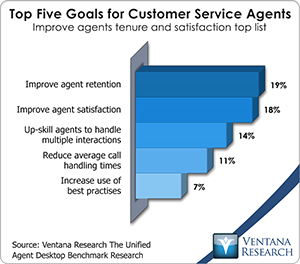I read a lot these days about how companies should pay more attention to  contact center agent or customer service representative satisfaction, as it can have an impact on customer experience and meeting key customer-related metrics. This is a far cry from the “good old days” when agents were often locked away in a dark, dismal place and told to answer as many calls as possible. My research into the agent desktop shows that many companies have indeed latched onto these new priorities, and the two top first ranked goals (19%) with respect to agents is to increase agent retention and thus keep the skills they have to handle customer interactions, and to improve agent satisfaction, which in itself helps ensure more agents stick with their roles longer.
contact center agent or customer service representative satisfaction, as it can have an impact on customer experience and meeting key customer-related metrics. This is a far cry from the “good old days” when agents were often locked away in a dark, dismal place and told to answer as many calls as possible. My research into the agent desktop shows that many companies have indeed latched onto these new priorities, and the two top first ranked goals (19%) with respect to agents is to increase agent retention and thus keep the skills they have to handle customer interactions, and to improve agent satisfaction, which in itself helps ensure more agents stick with their roles longer.
Over the last 10 years I have researched many aspects of contact center and customer-related performance management. Improving customer satisfaction has consistently been the top priority for most contact centers. However, when I look more deeply into what metrics companies use to judge contact center performance, then operational metrics such as queue times, average call handling times and hold times seem more important that customer satisfaction scores. But times have changed; customer retention has become more important and as a consequence the customer experience and customer-related metrics such as net promoter and customer effort scores have gained prominence.
Companies now must support more channels of communication, and agents are thus expected to handle interactions that arrive through more channels, which require different skills to handle effectively. What is more, they are expected to get it right more often than not, as first contact resolution rates have risen from a low level of importance to now one of the most frequently used operational metrics.
To meet their goals, companies need a new approach to managing the pool of employees handling interactions:
- My research into agent performance management shows that the majority of companies use spreadsheets to create and monitor agent work patterns. Spreadsheets are no longer able to address the complexity of allocating agents to different tasks, matching skills to different types of interactions and channels, taking into account non-full-time agents and those that work from home, or taking into account the different patterns of arrival of interactions from channels other than the phone. To meet these needs, I recommend that companies look at the specialist workforce management tools now available, and as they do so they should pay attention to how different products support agents having more input on their schedules.
- Agent performance can no longer be managed in isolation from the customer experience or customer-related targets. Companies need to look at how they can link customer feedback to agents that handled interactions and how agent quality scores reflect performance against key customer-related metrics.
- Companies need to examine how they can better support agents as they handle interactions. My research into the agent desktop shows that companies set agents tough targets in terms of the number of interactions of different types they must handle, handle times and first contact resolution rates, and agents are expected to meet these despite the fact that many have multiple applications open on their desktop and they have to spend valuable time navigating through individual systems and across systems. Companies should therefore look at the smart agent desktop systems now available, which can make the process of accessing applications more efficient and reduce the clutter on the desktop. My research into the agent desktop shows this technology can deliver a large premium. The research shows that that the agent desktop is a major contributor to agent dissatisfaction, and those companies that have deployed a smart desktop system are twice as likely to have happier agents, and happier agents are twice as likely to deliver on-target key metrics such as customer satisfaction, net promoter and customer effort scores.
- Companies need to reexamine the metrics they use to assess agent and contact center performance. My research into customer analytics and contact center analytics shows the majority of companies focus on operational metrics such as average handling times, queue lengths, hold times and transfer volumes. While these are important from a cost perspective, they are not good indicators of how well centers are meeting customer expectations. Companies therefore need a better blend of operational and business outcome metrics. To produce reports and analysis that includes outcome and trend analysis, once more companies need to move away from using existing reports or spreadsheets. I recommend companies look at specialist analytics products that can combine analysis of structured, unstructured and event-based data to produce the evidence about how centers and agents are meeting business goals and customer expectations.
In my experience, making sure you have the right numbers of skilled agents available to handle customer interactions has never been an easy task, and the task has become more complex as companies have to handle more forms of interactions, communication channels and locations handling interactions. At the same time, customer expectations have risen. It is therefore time companies stood back and evaluated the process, information and technology they use to manage this key resource so that they meet business goals and customer expectations.
Regards,
Richard J. Snow
VP & Research Director










